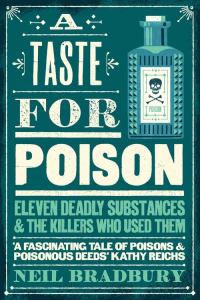As I’ve already mentioned, each poison has it’s own dedicated sections. There are comparisons with other poisons, how each one works in a similar or different way. Some counteract each other and there is discussion as to how some are even used to treat illnesses. The details of how a poison can stop electrical impulses and therefore cause the body to shut down, for example, are eye-opening. I definitely learned something from reading the book, without ever getting impression I was being taught.
As any reader of murder mysteries can tell you, poison is one of the most enduring — and popular — weapons of choice for a scheming murderer. It can be slipped into a drink, smeared onto the tip of an arrow or the handle of a door, even filtered through the air we breathe. But how exactly do these poisons work to break our bodies down, and what can we learn from the damage they inflict?
I thoroughly enjoyed A Taste for Poison. There wasn’t one bit that didn’t entertain or enlighten this reader. A fascinating look at how the smallest thing can wreck havoc on the human body, and how nature and science can be used to devastating and deadly affect.
Recommended.
Source – review copy
Published by Harper North
Each part deals with a differing poison, telling how it works, the symptoms and resulting deaths it can inflict on those who have been unfortunate enough to have ingested it. There are references to literature, Agatha Christie’s novels being just one example, a natural example to use given the novelist’s love of using poison as a murder weapon for her characters. There are also examples from real life cases, some more closer to us in history than others. This makes the book all the more fascinating when the reader can associate the scientific effects of the poisons with factual instances.
Now I love a good murder mystery. The golden age crime novels where murder was committed by slipping something into the after dinner port or utilising the eye drops of the elderly patriarch for nefarious means. But what about the actual poisons? How do they work and how often are they used in real life? Is poisoning really a woman’s murder method? When I heard about A Taste for Poison, I was keen to read it and find out more.
Drawn from historical records and current news headlines, A Taste for Poison weaves together the fascinating tales of spurned lovers, shady scientists, medical professionals and political assassins, showing how the precise systems of the body can be impaired to lethal effect through the use of poison. From the deadly origins of the gin & tonic cocktail to the arsenic-laced wallpaper in Napoleon’s bedroom, A Taste for Poison leads readers on a fascinating tour of the intricate, complex systems that keep us alive — or don’t.
In a fascinating blend of popular science, medical history, and narrative crime nonfiction, Dr Neil Bradbury explores this most morbidly captivating method of murder from a cellular level. Alongside real-life accounts of murderers and their crimes —some notorious, some forgotten, some still unsolved — are the equally compelling stories of the poisons involved: eleven molecules of death that work their way through the human body and, paradoxically, illuminate the way in which our bodies function.

Publication date – 20 January 2022
Poison. It’s long since held a fascination with crime writers, and for that matter crime readers. Agatha Christie has bumped off many a deserving, or undeserving victim with a pinch of arsenic here or a drop of atropine there. But how do these poisons work? What do they do to the body to make it shut down? And are they really used in real life? Neil Bradbury takes a look at 11 poisons, tell us how they work, and how they were used in cases that from history, some of which will be familiar to readers today.
There is scientific information in the book, there has to be really when discuss poisons and the chemical reactions that take place in the body when it enters the bloodstream. That said, the information is set out in a way to make it easy to understand, repeating where necessary but never condescending in tone. This isn’t a text book. It’s not written to prepare us for an exam. It does however provide fascinating information to the lay person and those who have read murder mysteries throughout the years and only seen the results of the poisoning from the pens of authors.







